|
Newlywed Togetherness
April 19, 1968
|
DOUBLE INDEMNITY-Mary and Fred Lambert received identical degrees in electrical engineering from Auburn University in March. Now they're at the Greenville Division of LTV Electrosystems in jobs they could alternate if necessary — and at the same salary.
Newlywed 'Togetherness' Applies to Identical Jobs
|
|
Anything he can do, she can do — maybe not better, but for the same salary.
Fred and Mary Lambert are "two of a kind" who practice identical, but separate jobs at LTV Electrosystems in Greenville.
The young couple, married only 79 days last March 14 when they received identical bachelor of science degrees in electrical engineering at Auburn University, had job-interviewed in duplicate since last September. Everybody wanted the couple. It's not often that twin capabilities are offered to the same company. LTV Electrosystems won the pair.
They began their careers as associate engineers at the Greenville Division March 18 — not in the same department, but each able to pinch hit for the other . . . and for matching salaries.
Why did the newlyweds want to work for the same company? "It's simple," Mary says. "This way we don't have any transportation problems."
Mary has always been interested in electronics. Her father, a retired Army officer, works in audio at Ft. Benning. As a child she always asked, "Why, daddy, why?" When his answers no longer sufficed, she enrolled at Auburn.
When she entered college, the dean of the School of Engineering told her, "You'll never make it — I mean, you're too good looking to get through without getting married."
|
Until last year, Mary was the only girl in most of her classes— and one of two enrolled in EE. She was the fifth girl to graduate from Auburn in EE, the first one since 1963.
Mary admits that studying was hard at college. "The men all seemed to study together and treated me as if I had just taken engineering to get a man. It was funny how they ended up getting hooked — but not by me. I was looking for someone special."
Fred and Mary met a year and a half ago during their junior year in college. They had a lab class together and two weeks after their first date they were engaged to be engaged.
Fred's fascination with electronics began when he repaired radios as a teenager. He entered Auburn in 1960. "I was stubborn about getting the degree and I wanted to pay my nwri way." He co-oped, dropped out to work, oped with the City of Mobile, Alabama, worked in the Mobile County Sheriff's office, and finally went to sea as a merchant marine to finish financing himself through school.
Mary takes pride in her expert cooking and her favorite hobby is "trying new recipes." She also enjoys participating in water sports.
|
|
Ringo
October 11, 1968,
July 19, 1968
|
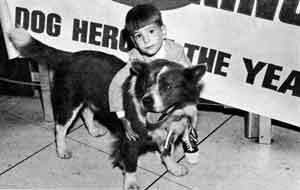
HERO — Ringo, part St. Bernard pet of the family of Ray Saleh, longtime field service employee at Vought Aeronautics Division of LTV Aerospace Corporation, was chosen “America’s Dog Hero of 1968”. He won gold medal, and collar, $1,000 Savings Bond, year’s supply of Ken-L-Ration and trip to Los Angeles for the Saleh family this month to receive prizes. Ringo received the honor for stopping 40 cars last April 30 on a blind curve in Euless to prevent them from hitting 2-1/2-year-old Randy Saleh. A curious driver finally investigated, found Randy playing on the road.
|
|
|
Ringo to Rescue, Keeps Saleh Boy From Being Hit
The infant son of Raymond L. Saleh might not be alive today if the boy’s dog, Ringo, had not been with him April 30 when he wandered out of the backyard of the Saleh home into a busy street nearby.
The boy’s father, chief of the field trials and modification section at the Vought Aeronautics Division of LTV Aerospace Corporation, said that time after time at the risk of his own life the dog literally attacked on-coming autos on Pipeline Road in Euless, hurling his body against fenders to prevent them from running down and perhaps killing two-year-old Ronnie Saleh.
The dog’s attacks were so furious and unusual that motorists slammed to a stop and watched, thinking Ringo was rabid. They were unaware that less than 20 feet away, hidden behind a rise on a blind curve in the road ahead, tiny Ronnie toddled down the highway alone.
However, Hurley Jones, one of the drivers, decided the dog wasn’t mad, but distraught and worried about something serious nearby. He investigated and saw Ronnie.
“It was amazing,” said Jones. “Every time he’d hear a car coming, the dog would run up the hill and stop the car. Then he’d wheel and run back to the child and try to nudge him off the road.”
|
|
Perfect Records
July 19, 1961
|
Perfect Records Earn $25 Bonds
Perfect attendance earns engineering department employees at the Vought Aeronautics Division more than just a pat on the back.
Later this month, each of the department’s 54 employees who have a perfect attendance record over the past three years will receive a $25 Series E U.S. Savings Bond.
Employees who will be recognized for three years of perfect attendance are H. E. Reynolds, R. K. Mahaffey, Jr., A. H. Rubeck, M. Brodhead, W. M. Roche, C. E. Wingate, M. M. Duppstadt, R. Batch- elder, I. L. Higgins, B. P. Noble, R. T. Holmes, J. R. Moore, P. P. Lucas, C. M. Warfield, E. Manning, E. A. Packard, W. F. Strawn, W. L. Bosworth, D. S. Thornbury, H. C. Allsup, Jr., H. A. Brown, Jr., T. F. Orr, P. H. Watenpaugh, E. C. Washington, H. W. Heinzman, W. J. Matthews, J. L. Jones, L. S. Dame, W. C. Heald, D. E. Poucher, H. F. Neil, F. L. Beissner, Jr., P. M. Gray, Jr., R. Santillan, Jr., S. W. McClaren, III, C. B. Thomas, and K. 0. Fessenden.
And J. G. Halpin, Jr., C. F. Lundberg, M. N. Amster, G. H. Perkins, Jr., F. B. Miller, R. A. Huffman, J. C. Chancellor, P. J. Willit, R. L. Williamson, D. R. Deere, R. J. Spivy, L. N. Blanc, B. H. Fuller, H. W. Wallace, B. J. Wheatley, R. H. Dennis, and J. 0. Hale.
|
|
Lassies
September 6, 1968
|
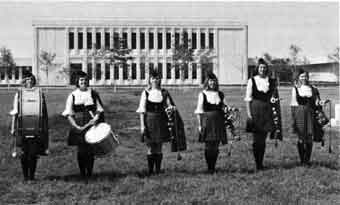
DEDICATION PERFORMERS — Six members of the Highland Park High School Lassies display the bagpipes and drums used in a musical salute to Robert McCulloch, a native of Scotland, during the dedication of the Robert McCulloch Research Center. Left to right are Leslie McKinley, Janet Latham, Becky Anders, Marilyn Vaughan, Jean Dolaway, and Sally Nesbitt. Director of the Lassies is Robert Jordan. The Grand Prairie High School Concert Band also performed during the ceremonies.
|
|
Featured Speaker At Dedication
September 6, 1968
|
Olin E. Teague Featured Speaker At Dedication
Olin E. Teague, a featured speaker at the Robert McCulloch Research Center dedication, was elected to the 79th Congress from the Sixth District of Texas in 1946 and re-elected to succeeding Congresses on the Democratic ticket.
Congressman Teague serves as chairman of the Committee on Veterans Affairs, is the second ranking majority member of the Committee on Science and Astronautics, chairman of the subcommittee on Manned Space Flight, and chairman of the Subcommittee on Legislative Oversight.
An alumnus of Texas A&M University and a resident of College Station, Mr. Teague was the subject in 1965 of a National Broadcasting Company-TV special, “Congress Needs Help,” which followed him through typical days in Washington, a trip to Cape Kennedy to witness a space launching and an inspection tour of the facility, and his days on a trip to the Sixth District in Texas.
Mr. Teague is a member of the American panel of a joint U.S.-Philippine commission to study problems involving benefits to Philippine veterans of World War II. The American commissioners were appointed pursuant to a U.S. agreement to join in a commission to study these matters.
He has been a member of the West Point Board of Visitors for the past 11 years, serving as a continuing member longer than any other member. He also serves on the President’s Blue Ribbon Committee on the review of Veterans Administration hospital installations.
|
|
MSD Facility Dedication
July 19, 1968
|
MSD Facility in Mainstream of Technological Progress
|
|
The principal speaker at the dedication ceremony for the new Missiles and Space Division facility in Grand Prairie told a crowd of several thousand that the new MSD plant is “truly in the mainstream of the technological progress which is reshaping our world and our lives.”
Lt. Gen. J. W. O’Neill, commander of the Space and Missile Systems Organization of the Air Force Systems Command, said facilities such as the new MSD plant come into existence because the United States has great men with the vision and the imagination to perceive the need and courage to build.
“Clyde Skeen (LTV president), Paul Thayer (LTV Aerospace Corporation president), and Gerry Monroe (vice president and general manager of MSD) are such men,” said the general. “All of you at LTV can be very proud of this day.”
President Skeen, in his dedication address, referred to the new MSD facility as an “award winner. I refer to it as an award winner because of the vital role it recently played in LTV’s selection for the Governor’s Industrial
|
Expansion Award for 1968.Without the construction of this multi-million-dollar complex, I think it would be fair to say that I would not have had the privilege of accepting the prestigious award on behalf of the company at Governor Connally’s Industrial Expansion Conference in Austin.”
He assured his audience, however, that the LTV Aerospace president and his management team had more in mind than winning an award when they decided to build the new facility.
President Skeen said their’s was a more lasting, long-term goal — one of placing MSD and LTV Aerospace in a better position to have a long-term competitive advantage that could be translated into more business, more profits for the shareholder, more jobs for employees, a more prosperous community, and a happier customer.
The climax of the dedication came when Dr. Monroe and his wife, Jeanine, performed the ceremonial ribbon-cutting, which signaled the official opening of the facility and the start of an open house and tour.
|
RIBBON CUTTING — Dr. Gerald M. Monroe’s wife, Jeanine, performs the ceremonial ribbon-cutting which officially opened the new Missiles and Space Division facility in Grand Prairie. Showing smiles of approval, left to right, are Clyde Skeen, president of LTV, Lt. Gen. .J. W. O’Neill, principal speaker at the facility dedication, Dr. Monroe, and Paul Thayer, president of LTV Aerospace Corporation.
DEDICATION GUESTS — Employees and guests who attended the dedication of the new Missiles and Space Division facility in Grand Prairie move toward the facility’s entrance immediately following the ceremony. |
|
Art Contest Winners
July 19, 1968
|
Art Contest Winners Named at Dedication
Four youngsters blessed with a Missiles and Space Division parent, a healthy imagination and a flair for the artistic are the proud owners of U. S. Savings Bonds as the result of the art contest sponsored by the division in connection with its June 22 dedication and open house program.
Names of the winners were announced by Dr. Gerald M. Monroe, vice president and general manager of the division, as part of the dedication ceremonies.
The youngsters competed for the bonds and winners’ ribbons by sketching their ideas of how their parents looked on the job, and it turned out to be a clean sweep for the girl contestants.
Best of show award and a $50 bond went to Patricia Johnson, 15, daughter of Tom B. Johnson of engineering.
Winners of $25 bonds in three age groups were:
Ages 7 and under: Linda Dee Simpson, 7, daughter of Hack Simpson in accounting.
Ages 8 to 12: Debbie Lang, daughter of Art Lang, Jr., in engineering.
Ages 13 to 16: Kathryn Lee Freeman, 16, daughter of Fred D. Freeman in quality control.
|
|
Birthday for Treva
November 3, 1961
|
It's Happy Birthday for Treva
|
|
By HOWARD WILLIAMS
A pretty 3-year-old girl with soft blond hair and blue eyes was seen one recent noontime gripping a sack lunch in both hands and running to meet her Chance Vought-employee father who was coming from an exit of the Dallas-Grand Prairie plant.
Not many people would have thought it unusual to see the child running that noon, or any other noon when she and her mother came to meet "daddy" for lunch.
Still, not many would have believed that less than two months before the little girl had been in critical condition for 72 hours following a serious four-hour, open-heart operation using 12 pints of blood from CVC employees.
There were times during that long operation to close the hole in Treva Gayle Kuhn's heart that her father — Charles R. Kuhn of the unit 783-1 paint shop — and Ruby. Treva's mother, thought they might lose Treva.
But this hadn't been the first time Ruby and Charjes worried about Treva's welfare. Just hours after she was born on Nov. 4. 1957, she caught pneumonia, and she spent most of the following 12 months in and out of doctors' offices. At 18 months Treva had a case of measles which nearly took her life.
Naturally. Treva's parents wanted her to have the health their other two daughters — Janan,6, and Debra.9—enjoyed. And the open-heart surgery was scheduled for last Aug. 31, and successfully performed at Chil-drens' Hospital of Texas, in Dallas.
"I'm so thankful for the help of my company, plant "B" hospital personnel and the blooddonors," Charles said.
|
"They all have helped give us something extra special to celebrate on Treva's fourth birthday tomorrow," he added, "and I wish I could thank everyone personally."
All of the following gave Treva blood: J. S. Hodges, Jr., Earl Hastings, E. R. Howell, H. K. Guynes, Homer Tracy, George Pool, J. M. Tushim, W. P. Gibson, W. L. Kennedy, C. V. Kun-kel, J. L. Moore and J. G. Bailey.
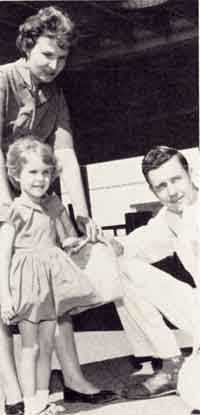
Treva Kuhn will celebrate her fourth birthday tomorrow, thankful for 12 pints of CV employee blood given her during open heart surgery. With her are parents C. R. Kuhn, unit 783-1, and Ruby Kuhn. In sack is lunch for Treva and dad.
|
|
Pearl Harbor - 20 Years Later
December 1, 1961
|
Pearl Harbor Remembered-20 Years Later
|
|
By ELDON CORK ILL
It doesn't seem that long ago.
But it was about 20 years ago. on Dec. 7. 1941. that America suddenly ceased being the "arsenal of democracy" and jumped overnight into the thick of a world conflict. Most LTV employees remember the day well.
Many civilians were disbelieving when fragmentary word of the Japanese attack on Pearl Harbor came over the radio. Men already in service were better briefed and expected trouble — but they didn't know where or when.
The Dec. 7 attack had tremendous effect on the lives of many LTV employees.
'Mad Morning'
Fred Godeman, equipment requirement analyst with Chance Vought. was one of those who took the fast jolt at Pearl Harbor, where he had lived for many years as a Navy civil service employe. He retired last April after 36 years with the Navy.
His story of that day, along with those of other LTV employees, can best be summarized by his statement that it was "kind of a mad morning."
His house was two miles from the Navy Yard gate. He was at home when the bombs started falling, and heard a radio call for all employees to report for duty.
He was enroute to his job in aircraft maintenance on Ford Island when a big bomb hit the USS Pennsylvania. The concussion was so great that it picked up the car in which he and others were riding and deposited car and riders on a sand dune. Although they later found metal fragments in the upholstery, no one in the car was injured.
Godeman boarded a small boat to get to his duty station. The USS Nevada was being strafed and bombed, the USS Arizona was taking hit after hit, and the USS California was settling to the bottom.
"It was a rough, smoky, hot morning," he says. "Smoke was thick. Everything was so black it was like night except for the fires. The whole bay seemed to be on fire. There were sailors in the water — but we couldn't get to them.
Kept Guns firing
"The boys on the Arizona and the California had it the worst. It was amazing how the boys on the California kept their guns firing—they were still firing when the decks were awash."
Godeman was busy almost around the clock for many days, trying to salvage engines and get more airplanes ready to fly. As a souvenir of the "day of infamy" he now keeps on his desk an aluminum ash tray — made from metal in one of the 19 Japanese planes shot down.
The first heavy rain after the attack, Godeman found his house roof had been pierced by bullets. His family evacuated the home during the bombing, but had extreme difficulty leaving the area because all roads were clogged by fleeing people. "It makes you wonder if civil defense evacuation plans will actually work," he said.
Changed Lives of employees
Others far removed from Hawaii heard the news over the radio. The attack also was to change their lives.
I. D. Teakell, in Brake & Roll section of Unit 771-1, Dallas B plant, was a youngster at home when he heard the news over the radio. In 1943. when he was 17, he joined the Navy, eventually serving on the small
|
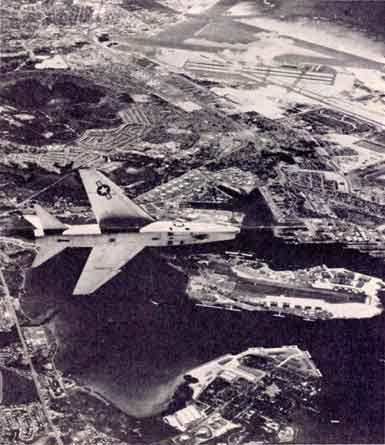
PEARL HARBOR, 1967
A Crusader is shown banking over today's Pearl Harbor, where the United States first felt the impact of World War II. On the upper side of Ford Island, just under the nose of the Crusader, the Japanese found our battleships docked. At upper right can be seen Hickam Field, where the attackers knocked out most of the equipment the Army Air Corps had in Hawaii.
|
|
aircraft carrier Barnes. Jerry Eades, of Plant B's detail shop, now VFW commander for seven counties south and west of the plant, was a bugler in the 8th Cavalry Regiment at Fort Bliss when he heard the news, and blew the official call to arms for his unit, putting everyone on alert. He joined the 1st Armored for the North African invasion, was wounded in Sicily, then took part in the Normandy invasion, June 6, 1944. He was wounded more seriously in Germany and that ended his 10 years of Army service.
Was in 'Lost Battalion'
Jim Myers, general insurance administrator in the LTV insurance office, was taking tickets at the Midland theatre in Pittsburg. Kans., when relatives told him the news. "I remember thinking that I would be on my way soon," he said. And he was, as a turret gunner on a Navy P4BY-1 patrol bomber in the South Pacific area.
Pearl Harbor news reached W. P. (Bill) Robertson of the Aerosys-tems Division already at sea, aboard a convoy enroute to the Philippines. The group. Battery F of the 2nd Battalion. 131st Field Artillery, heard tha news over the ship's loudspeaker system. They were told at first only that "a state of war exists between the United States and Japan," and that "units are already engaged" at Pearl Harbor. Later, as the convoy circled awaiting instructions, they set up a radio loudspeaker system and began to hear fragmentary news reports about Pearl Harbor. The group went to Australia as the first U.S. troops to arrive there, then to Java, where the "Lost Battalion" was quickly lost when the Dutch surrendered the island. Bill and his companions spent the rest of the war in prison camps,some surviving, others not. He still likes rice, which was the best food he received during his long prison stay in Southeast Asia.
Was Near Manila
L. M. Ezell, foreman in parts control in the Aerosystems Division, was a chief electrician's mate on the submarine USS Permit in Cavite Bay, just across from Manila. His executive officer woke him up, told him about the Pearl Harbor attack, and told him to get everybody off topside and prepare to get under way. The submarine went to Java, where it made contact with the
|
131st Field Artillery (the 'Lost Battalion') at Malang. Ezell later was transferred to the submarine USS Ling. Dave Lane, section manager in contracts and sales. Aerosystems Division, was a chief radioman on the crew of the XPBS. flag plane of Secretary of the Navy Frank Knox. He received a telephone call to be ready to take off in 20 minutes. The plane flew a congressional and military top-brass group to Panama to gird that canal area for a possible Japanese attack. A few days later, he flew with the plane to Pearl Harbor, taking a commission which assessed damage.
Bob West, scientific computing analyst at Garland now. had just returned from church in Dallas when he heard the news about Pearl Harbor. He was "ready to go" and was later in the 90th Infantry Division, hitting the Normandy beachhead as part of D-Day's second wave. An artillery blast inside Germany left him unable to speak, and he had long hospital treatment before resuming civilian life. Capt. A. C. Holt. Jr., Bureau of Naval Weapons Representative, had left Pearl Harbor in April that year to become a flight instructor at Corpus Christi. He heard the news over the radio and immediately packed up, expecting to get combat orders. Instead, he continued the stepped-up training of pilots at Corpus Christi, then got sea duty again in 1943.
Saw Hiroshima Blast
For A. G. (Bud) Grice of the Electronics Division, the Pearl Harbor attack led from Winnsboro. Tex., to Hiroshima. He heard the news over the radio while at home in Winnsboro. Too young to join, he already had his eyes on the Air Corps cadet program. Eventually, he was pilot of a stripped-down B-29 photographic plane, flying in the Hiroshima area of Japan on Aug. 5, 1945. Nearby, another B-29 dropped the A-bomb — an event concerning which Grice and his crew had no prior knowledge.
"We thought they had hit the world's biggest ammunition dump.'' he recalls. He continued to fly in the area for about three hours, taking pictures with 16 cameras — among them plenty of pictures of a peculiar-looking, mushroom-shaped cloud which forecast an early end to the war.
|
|
Congressional Medal of Honor
December 1,1961
|
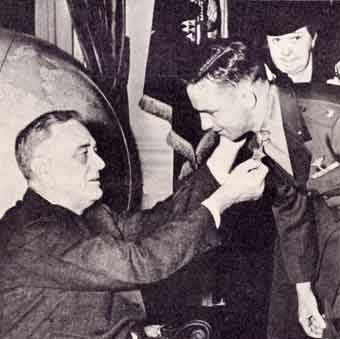
GETTING CONGRESSIONAL MEDAL OF HONOR
This picture, taken in 1943, shows R. E. Galer, vice president and general manager of the CV Aeronautics & Missiles Division, receiving the Congressional Medal of Honor from President Roosevelt. Mrs. Mary Galer, mother of the Marine flyer, looks on. The CMH was awarded for Galer's leadership of a Marine .squadron in the Guadalcanal campaign and his shooting down of 13 enemy planes in a 29-day period.
|
|
Col. John H. Glenn
December 1, 1961
|
Bulletin!
Lt. Col. John H. Glenn, Jr., who piloted a Chance Vought Crusader to the first supersonic flight across the U. S. back in 1957, has been selected as the astronaut to make the nation's first manned orbital flight, NASA officials announced this week.
The 40-year-old Marine pilot has been closely associated with the company over the years, and at the time of his historic flight was F8U project officer for the Navy Bureau of Aeronautics. Date for Col. Glenn's next history-making flight has not yet been determined.
|
|
National Secretaries Association
December 1, 1961
|
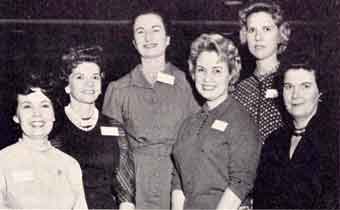
THEY LOVE COMPETITION
These CVC employees, members of National Secretaries Association, Golden Triangle Chapter, were on hand recently for initiation of 82 girls into the Future Secretaries Association at Grand Prairie High School. From left are Doris Cox, Edna Beebe, Flo Short, Elza Carter, Wanda Richards and Cathv Brown.
|
|
Astronette
January 19, 1962
ASTRONETTE READY TO GO!
Jerry Sloan — one of the nation's 12 astronettes — is viewed in the LTV Aerospace Flight Simulator during a visit to CV Astronautics last week. "If they would call me tomorrow to make a shot to the moon, I'd be ready to go," the pretty astronette said. |
|
THE LTV AEROSPACE SIMULATOR
"Its Fabulous!" Says Astronette
|
|
By JO ANN GOODEIL
"It's fantastic — just fabulous!" Jerry Sloan—one of the nation's 12 astronettes — exclaimed after gingerly stepping from the cockpit of LTV's Aerospace Flight Simulator following a visit to CV Astronautics last week.
"I want to call Jerrie Cobb (NASA's consultant for Women in Space) this weekend," she continued, "and tell her about it. I wouldn't be surprised but what she would want to bring all the girls down."
No wonder Astronette Sloan, a blue-eyed brunette and mother of a 9-year-old son, was excited. LTV's simulator is a vehicle in which an astronaut—or an astronette!—can make realistic orbital, lunar and interplanetary "flights" viewing the movement of the vehicle in "space" —experiencing problems and stresses like those an actual space vehicle would encounter.
And pretty Jerry Sloan loves to fly—in fact has been flying since as a toddling youngster, she used a dining room chair and a lot of imagination to "fly" her aircraft on the floor of her parents' home in Amarillo.
"Space is our last frontier," Jerry states. "You can't get rich but there are rewards. We're pioneering." Jerry, a petite five-foot, three-inches tall, with a "payload" of 103 pounds, continued. "I'll never forget the day Alan Shepard made his flight. I sat there and cried. It was an emotional, moving experience. .. . Jerrie Cobb called me and her first words were, 'This is wonderful! Now if we can just get a woman up there!' "
How did Jerry become an astronette? The government pulled the files on U. S. women pilots with a minimum of 500 hours flying time. Jerry's was there. The Lovelace Foundation wrote her a letter asking if she would be interested in taking the tests. "When my son, David, heard the news he was so excited that he ran outside and told the neighborhood kids, 'My mother's going to the
|
moon, my mother's going to the moon!'
"You can imagine what happened," mused Jerry, "they laughed at him. So I took my letter and read it to some of the mothers.Then you should have seen the way they looked at me!"
It was Jerry's career in flying that resulted in her being selected as one of the astronettes—the only one from Dallas, and the only one who is a mother. ("That is. unless something has happened very recently, I'm the only mother," Jerry grinned.) Her first airplane flight was made when she was a freshman in high school. "It was an open cockpit, single-engined Waco, and that pilot was more interested in impressing than in teaching. He really wrung me out!"
Since then she has received her license, ferried, raced and now owns part-interest in Air Services, Inc., a business at Addison Airport.
Jerry first got her "feet wet" flying in the Skylady Derby. She has won the Dallas Efficiency Race the
last three years and in 1961 she placed second in the Skylady event. She is chairman of the Dallas Chapter of "99's"—a group she admits is "guilty of 'hangar flying' at meetings. We use our hands, feet and toes trying to tell the largest story!" she laughed.
Comparing America's astronettes to astronauts, she commented, "I think officials were surprised to learn from our tests just how well women stack up. We can take intense pain and isolation better than men, but when it comes to technical know-how, the men are better trained."
Having passed all the tests for which she has thus far been called. Jerry keeps in touch with NASA Consultant Jerrie Cobb. "All my letters from her start: 'Dear Flat'." she smiled, adding. "Flat meaning 'Fellow Lady Astronaut Trainee.' "
"One thing for sure." commented Astronette Sloan, "if I don't get to make that trip into space, just wait —in 10 years I'll have a son ready to go!"
|
|
Fallout
June 1, 1962
|
|
|
Spring has finally arrived, we hope, and everybody is becoming active with hobbies — ranging from golf to embroidering. In golf, Wes Harper of Astro engineering, Tim Murphy, also of engineering, and Dick Doores, product design, were playing at Norwood on a par 3, 220-yard hole. Nope, you're wrong — it was no hole-in-one. It's more like two-holes-in-two. Murphy's second shot, the approach from 25 yards out, hit Harper's ball, already on the green, and both went into the hole. Two birdies in one shot.
And an Oklahoma City woman apparently is stirred up by spring weather. She has written for some "three-quarter views" of airplanes for embroidering patterns.
Our own springtime activity centers around trying to paint the house—with one eye looking toward the closest golf course and the other pointed at the nearest fishing spot.
—O—
Astronaut Donald Slayton, temporarily "earth-bound" because of a slight heart flutter, paid a business visit to the Grand Prairie plant Wednesday, March 28. Good thing he was too busy for us to catch up with him — we need an answer to our 7-year-old's question: "How high do you have to go to have a full moon all the time?"
—O—
For you fans of dutched-up English, here's a sign which Space Age News says is located near a computer at the AEC facility, Los Alamos, New Mexico:
A C H T U N G !
Alles Lookenspeepers
Das computenmachine is nicht fur gefingerpoken und mittengrab-ben. Is easy schnappen der spring-enwerk, blowenfusen, und poppen-corken mit spittzensparken. 1st nicht fur gewerken by das dumm-kopfen.
_Das rubbernecken sightseeren keepen hands in das pockets — re-laxen und watch das blinkenlights.
—O—
Or, translated for Texas, it says: "Keep yer cotton-pickin' fingers outta there!"
—O—
Some more sobering thoughts: April 15 is the deadline for having your car inspected. And don't forget Uncle Sam wants to hear from you the same day concerning your income tax.
—O—
QUOTE: "Let no wishful thinking blind us to the indisputable fact that the Communists are completely committed to their goal of world conquest."—Secretary of the Army Elvis J. Stahr, Jr.
|
|
Goodwill
June 1, 1962
|
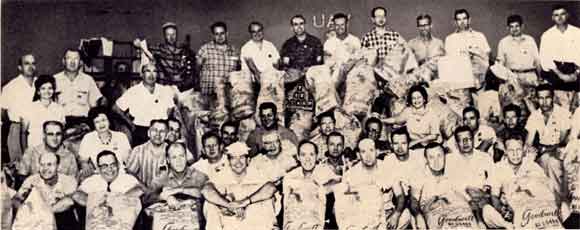
GOODWILL-AID TO HANDICAPPED
LTV employees at Dallas County facilities returned approximately 1,500 bags of clothing and repairable items in a quick campaign for Good will Industries, which employs handicapped persons. Shown with a pile of the filled bags are members of UAW Local 84S. who handled the chore of distributing the bags at plant gates. The items donated are refurbished and sold at Goodwill stores in Dallas.
|
|
|